Industrial buildings and public housing estates are just some of the words commonly associated with Lai Chi Kok in Kowloon. But aside from that, it’s also home to a ton of restaurants, from cheap eateries to slightly more expensive fare. One of the restaurants to fall in the latter of these two categories is Man Hing.
Man Hing is the Greater China Club’s traditional Cantonese restaurant serving banquet-style dishes and decked out like an Art Deco jazz club. Except, this banquet restaurant is not so well-hidden on the 10th floor of a former industrial building, now mall, that’s just a stone’s throw away from Lai Chi Kok MTR station (which is a 40-minute MTR train ride from Central).
You don’t need to be a member of the Greater China Club to dine at Man Hing, but with corporate and individual membership packages on offer (member privileges include no service charge, having priority on waiting lists, and first dibs on promotions and offers), it’s the kind of place targeted at people working in the area who want to take clients out for a business dinner, but due to the location, may have trouble finding a spot that’s a bit more sophisticated.
Since opening its doors in 2015, the restaurant has been serving “nostalgic” Chinese dishes. For a limited time (April 3 to April 22), they will be serving up a special “Taste of Guangdong Nostalgic Dining Experience” menu, a collection of dishes chosen by guest chefs and brothers Heung Chung-Kin and Heung Chung-Tat, that features popular Cantonese dishes from the 1960s to 70s. The chefs, both in their 60s, have a track record in heading kitchens at a number of big-name hotels like the Grand Hyatt in Hong Kong and ANA InterContinental Tokyo, and are also about to retire.

So as something of a parting gift, they’ll be serving more than 70 Guangdong dishes including dim sum, appetizers, mains, and desserts at the Greater China Club’s Cantonese restaurant.
An important thing to note is that for a lot of Chinese dishes, texture is just as paramount as flavor — the concept of kou gan or hau gam — where part of enjoying Chinese food is not just the flavor but experiencing the different kinds of textures that each dish yields, which can be anything from crispy to slimy.
If you’re someone who isn’t used to eating Chinese food or just not particularly fond of internal organs or feet, some of these textures might be a bit strange or unpleasant. But if you’re someone who really enjoys a number of these interesting textures, you’ll most likely enjoy this.

Let’s start with the “safe dishes” that everyone is guaranteed to like. These include items like the deep-fried Chinese egg puddings with Yunnan ham (HK$138), which had a nice savory egg flavor and encased in a slightly crispy outer shell, and the sautéed prawns stuffed with Chinese ham and bamboo shoot (HK$288), which arrived beautifully plated and nicely seasoned with Cantonese-style sauce that carried hints of soy sauce and sesame oil.
The two items that did blow us away, however, were the deep-fried caul fat rolls stuffed with shredded pork and eel (HK$188), and the braised vegetarian pockets stuffed with mushrooms and vegetables (HK$168).
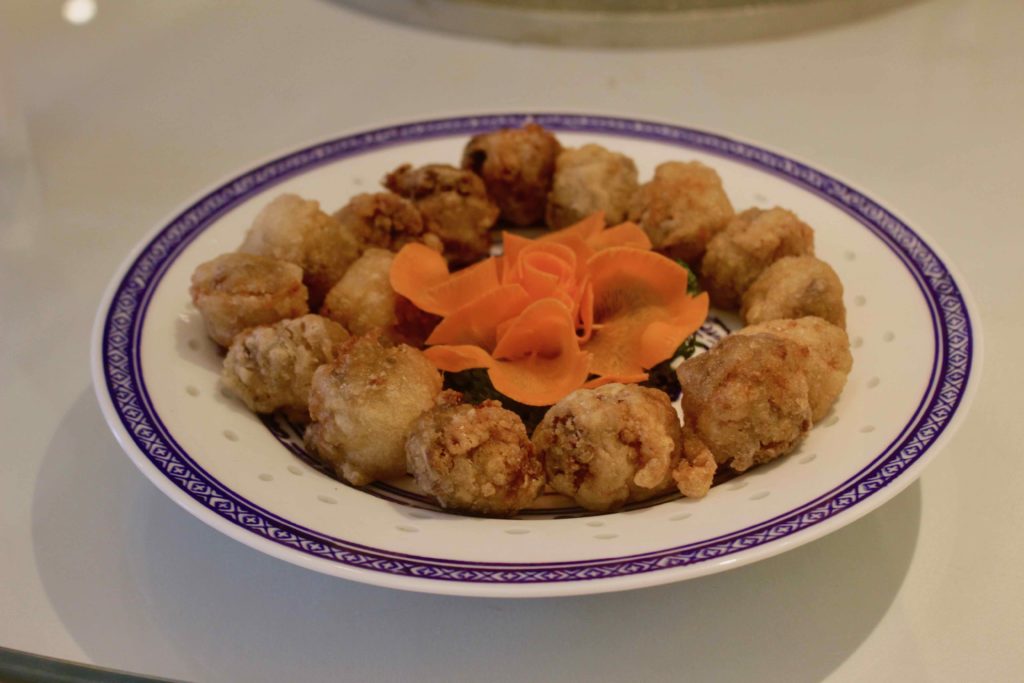
The caul fat rolls — caul being the thin membrane that surrounds the internal organs of some animals, in this case a pig — packed in a lot of flavor from the pig fat and the pork.
Similarly, the vegetarian pockets were bite-sized, deep-fried in a light batter, and each bite was like an explosion of earthy mushroom flavor in your mouth, with a slight sweetness and crunch from the carrots that complemented the mushrooms.
Other safe dishes on the menu included the soups. We tried the braised partridge soup with bird’s nest (HK$188 per person), and sliced noodles with crabmeat in superior soup (HK$88 per person). The superior soup had a nice seafood flavor, although it did get overpowered by the noodles — made from won ton skins — which had that pretty strong wonton skin aftertaste.
The braised partridge soup however was very good, it had the same thickness as a slightly runny congee, and had a nice and hearty savory taste.

Now, moving onto the slightly more divisive dishes — and we’d argue more exciting dishes — such as duck webs, preserved eggs, pork intestines, and pork stomach.
The preserved eggs (HK$88) were served cold with the yolk slightly runny, giving it a bit of a cold slimy texture. We enjoyed this and wished the flavor of the preserved egg was a little bit stronger, but for those who found the egg a bit too strong for their liking, this dish comes with slices of pickled ginger as palate cleansers.
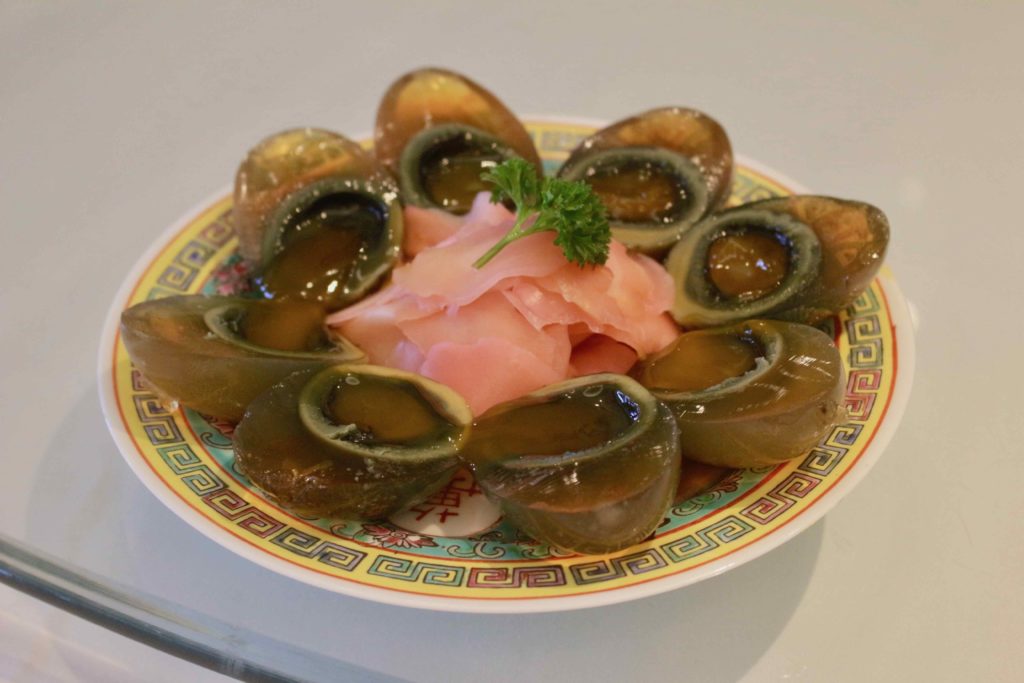
Within the cold appetizers, we particularly enjoyed the marinated boneless duck webs (HK$128). If you enjoy eating Thai cold chicken feet salad, you’d definitely enjoy this. There’s no ungracefully spitting bits of cartilage onto the table with this item, it’s nicely marinated with spring onion and sesame oil, not too oily, and there’s a bit more chew to this than chicken feet.

There were two dishes of which there will only be a daily limited supply, and they are the braised dried giant garoupa skin with thick sliced abalone in oyster sauce (HK$488), and the sautéed pork stomach with olive kernel and bell pepper (HK$298).
Abalone is one of those Chinese banquet dishes that some people either love or hate, and Man Hing serve theirs with a side of braised dried giant garoupa skin, one of the staples in a Manchu Han imperial feast. The HK$488 price tag for this one is steep, and then we were told that the dried giant garoupa skin came from Malaysia, which costs over HK$5,000 per 9 kilograms.
The garoupa skin didn’t have much of a taste, it was served with lashing of abalone sauce, but it had a texture similar to that of beef tripe, which was a nice contrast to the smooth and chewy abalone.
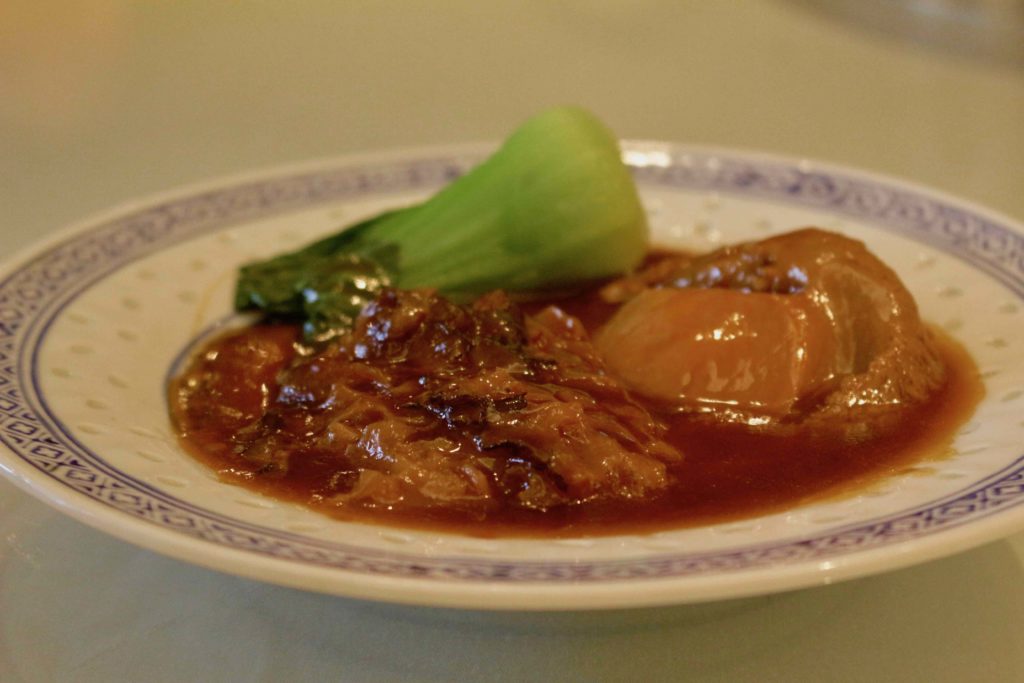
Speaking of chewy, we managed to fish out a bit of pork stomach which was hiding underneath mountains of bell peppers. The whole dish was nicely-seasoned, but we did struggle to find enough pieces of pork stomach, and the one bit of pork stomach we had was tender, a bit rubbery and chewy (in a nice way).
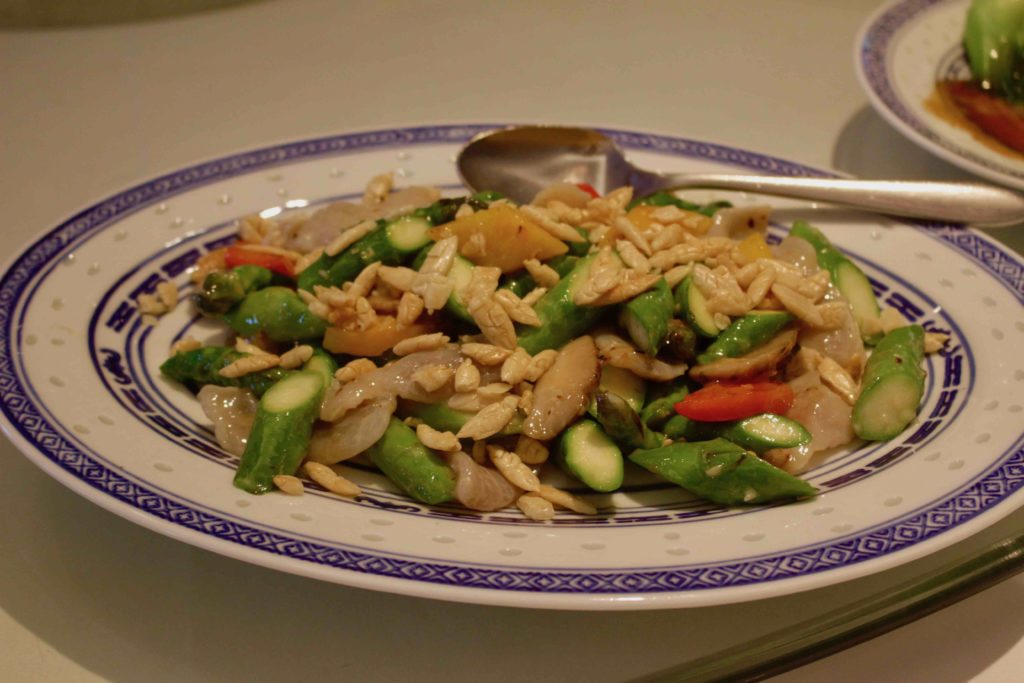
We liked the toasted pork intestines (HK$138), which also had a bit of a rubbery texture and a slight chew. There isn’t an overpowering taste of innards, so this would be the dish to have if you’re someone particularly squeamish and looking to bridge that gap from safe to “strange” foods.
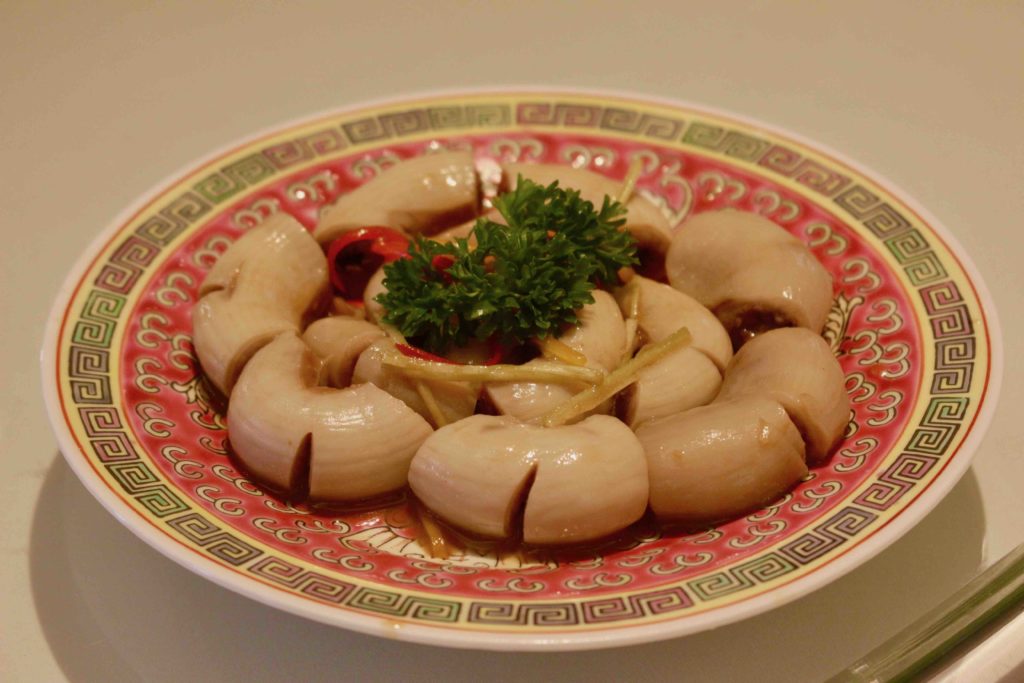
The deep-fried eel with osmanthus sauce (HK$338) was a dish we were a bit on the fence about. We liked the crispiness of the deep-fried eel, but were thrown a bit with how sweet the osmanthus sauce was to the point of overpowering the eel.
That said, this was an interesting combination of flavors and one definitely worth trying here.
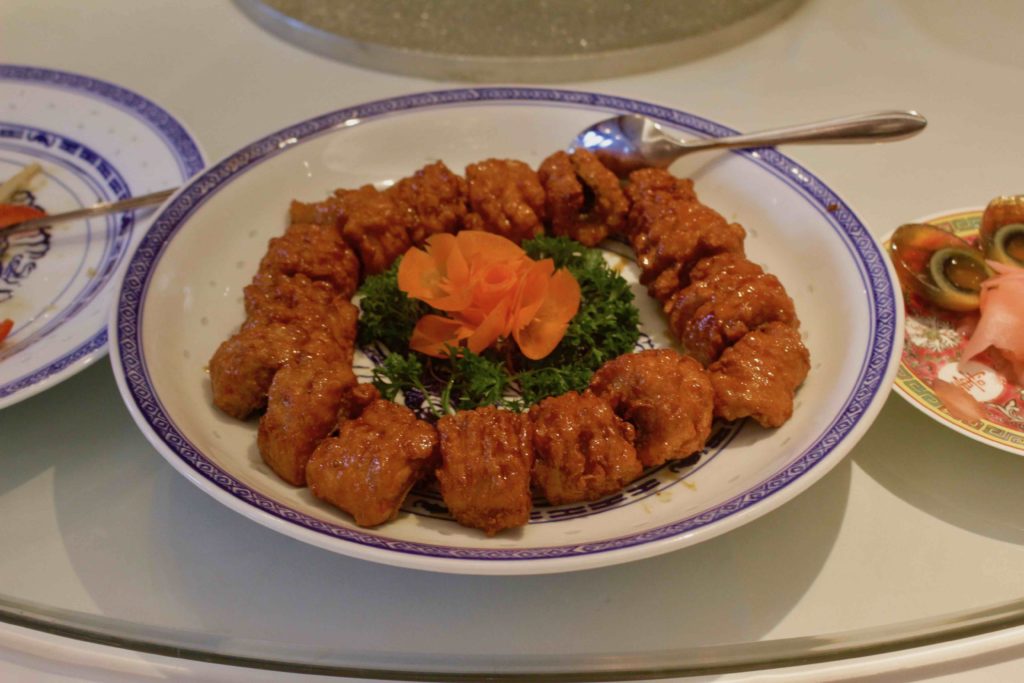
One dish that was especially divisive among the diners at our table was the braised pomelo peel with shrimp roe (HK$188), which was made of pomelo halves that had been braised, then covered in a strong, savory seafood sauce.
There was a lot going on here, and a considerable amount of time is spent trying to get your head around the flavors (it’s a pomelo, but it’s salty instead of sweet, mushy instead of crunchy, and overpowering instead of delicate). The pomelo has been braised to the point where the taste of pomelo has been squeezed out of it and instead replaced with a salty, shrimpy taste. It’s an experience worth trying once, but probably not something we were clamoring to get seconds of.
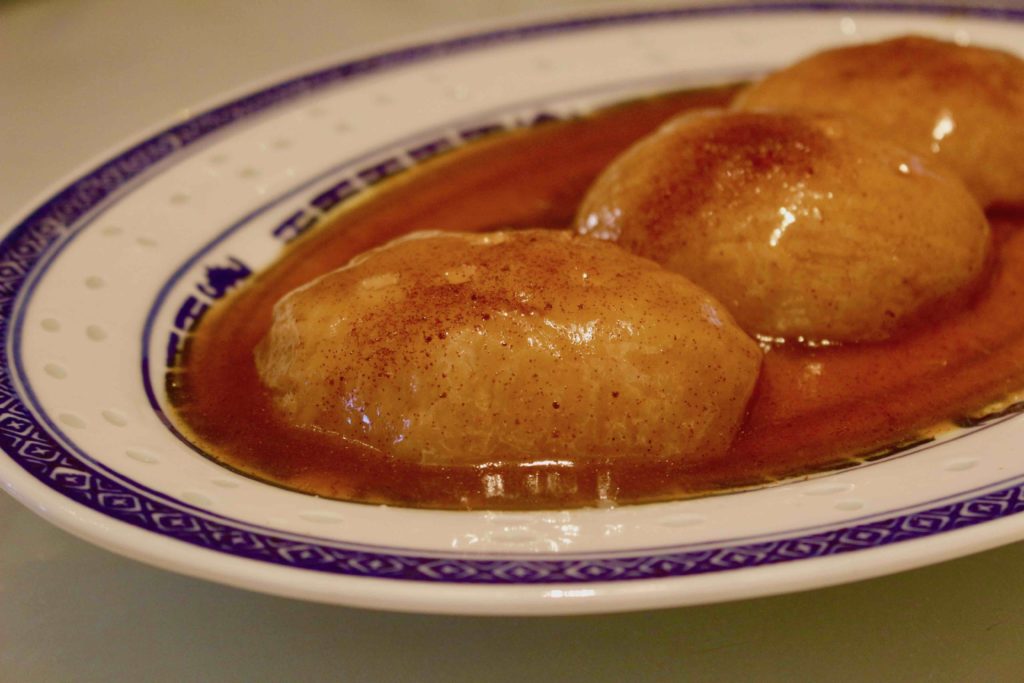
On to the desserts — the red bean rice flour pudding, or put chai ko ,is a palm-sized pudding shaped like a bowl and made with red beans. It’s a childhood favorite for a lot of Hongkongers who grew up eating the sweet pudding.
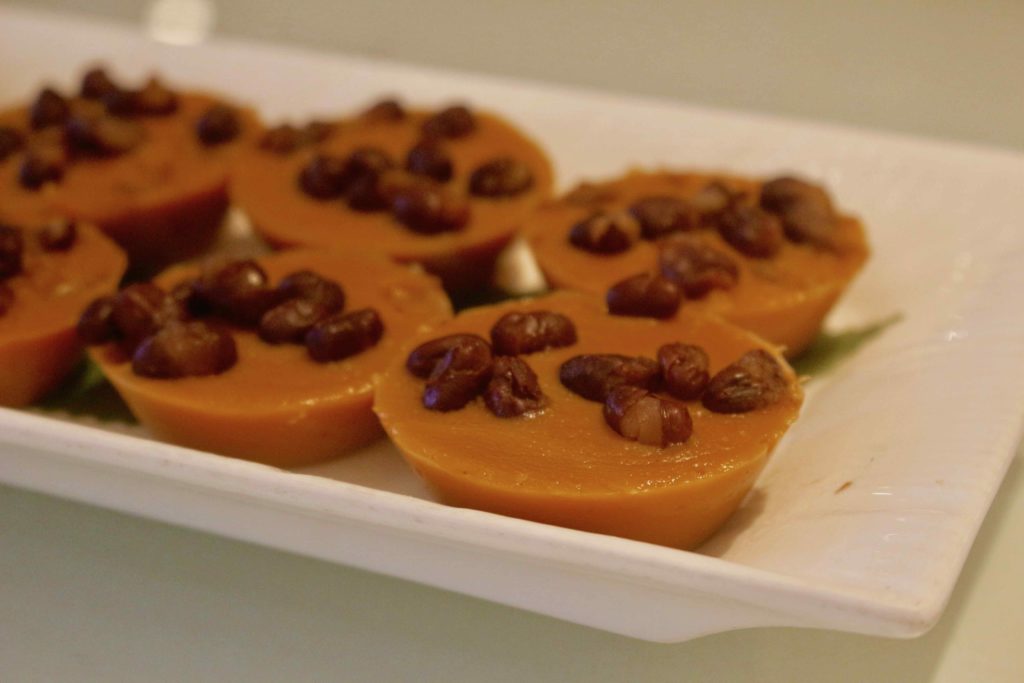
The red bean really stands out in this dish, and it’s an interesting combination of softness from the pudding and the pleasant mushiness of the red bean.
If you’re not a fan of red bean, another pudding-type dish you could consider is the sweetened black sesame rolls, which again has the same soft texture of the put chai ko, but also a subtle sweetness from the black sesame.

But for those of you who like their desserts to be a little bit sweeter, the deep-fried twisted egg puffs with honey syrup (HK$48) is a fun dessert; the whole thing crumbles with each bite, it’s fluffy and light, delicately sweet — just the right end to a heavy meal.
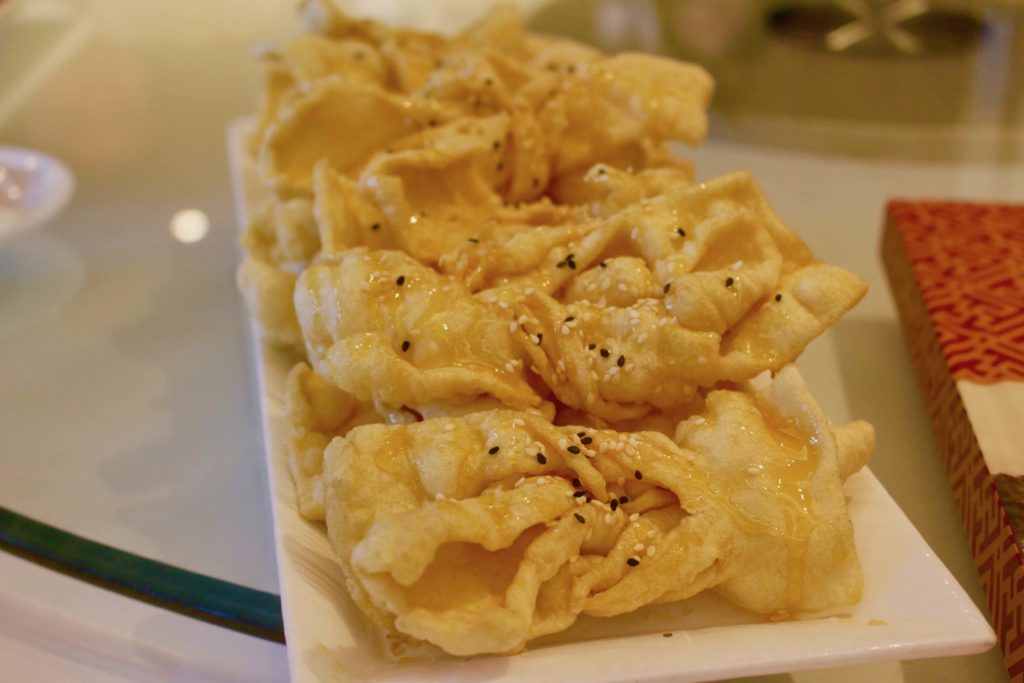
Overall, Man Hing has echoes of many Chinese banquet-style establishments like Peking Garden, in that they serve up delicious and elaborate traditional dishes, often featuring hard-to-source and expensive ingredients.
But unlike Peking Garden, Man Hing is definitely more of a quiet affair — more of a place where you take colleagues and clients, and less of a place where it feels like you can let out a huge belly laugh with a friend.
The items listed in this review can comfortably feed between 15 to 20 people, and will set you back between HK$170 to HK$200 per person.
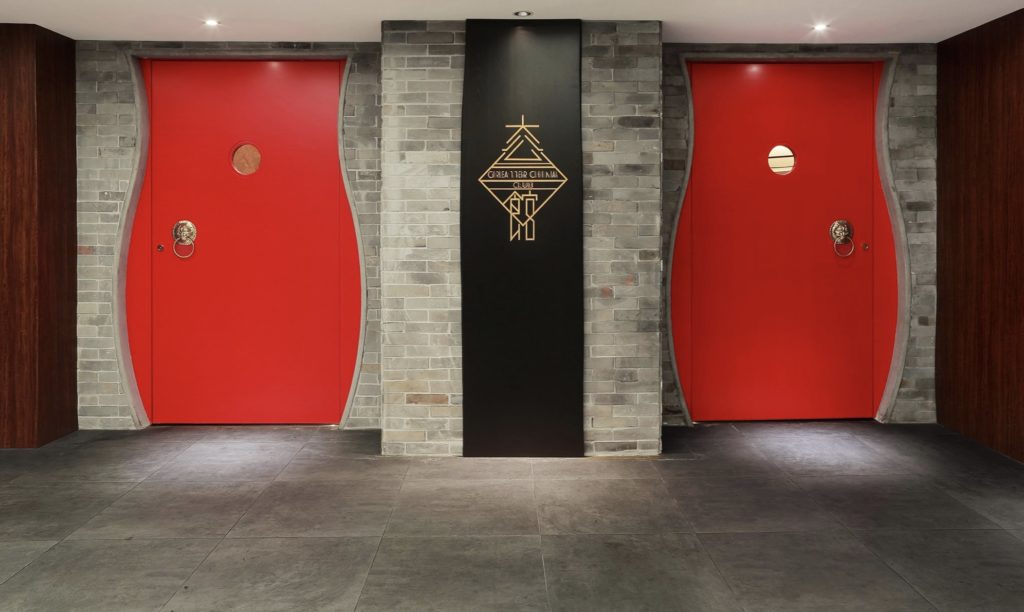
FIND IT:
Man Hing is located at Greater China Club, Unit A, 10/F, D2 Place, 9 Cheung Yee Street, Lai Chi Kok, Kowloon
Phone: +852 2743 8055
Open Mon-Fri, 12pm-2:30pm and 6pm-10:30pm; Sat-Sun and public holidays, 11pm-3pm and 6pm-10:30pm
MTR: Lai Chi Kok (approx. 1 min walk)





Reader Interactions